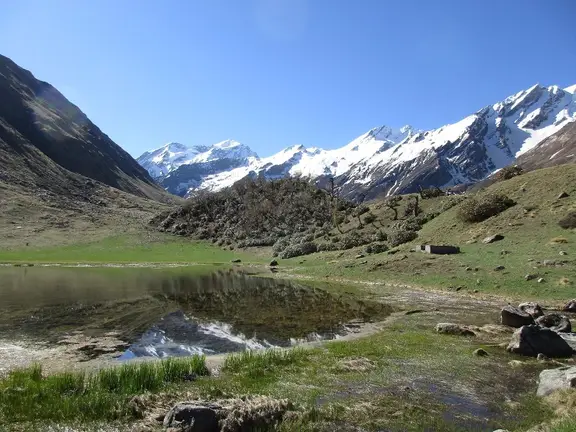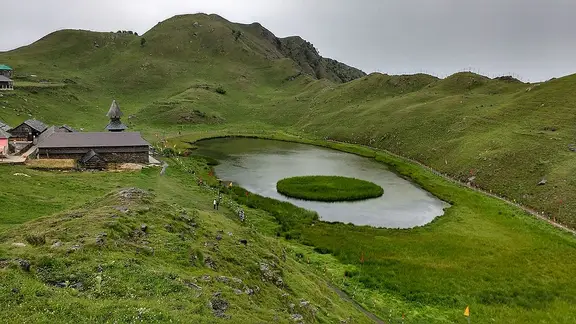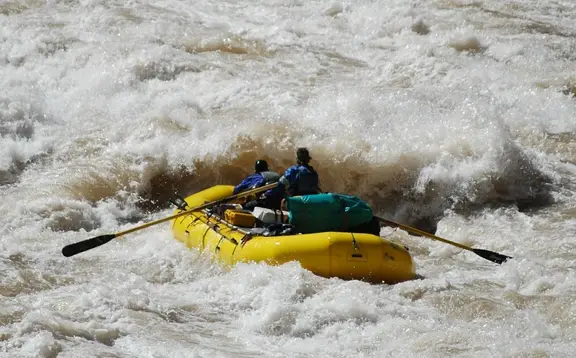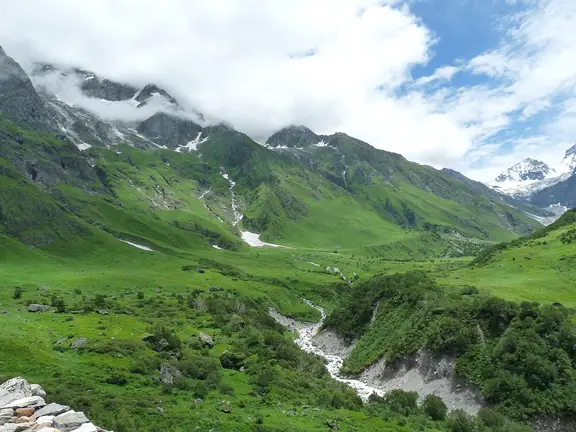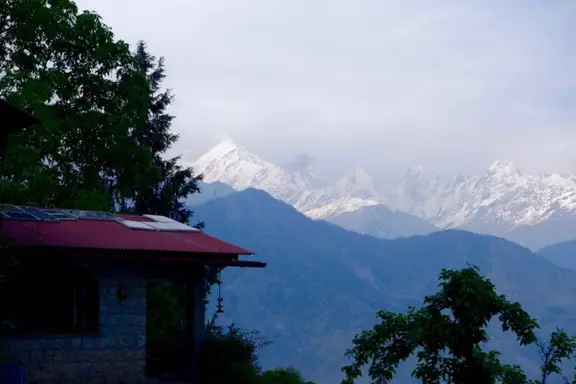Why Ruinsara Tal via Har Ki Dun Is Not A Good Option?
One of Uttarakhand’s most poignant treks – the Har Ki Dun Trek is beauty personified with its lofty snowcapped mountains, verdant valleys, mysterious forests, and rich heritage & culture. Sitting pretty at a height of 11,675 ft Har Ki Dun has acquired somewhat of a celebrity status among nature lovers and adventure enthusiasts alike. For only a handful of treks come bundled with both charm and thrill, in equal measures.
Located at the foot of the Fateh Parvat, the trek to Har Ki Dun commences from the charming little hamlet of Sankri, located in the Jaunsar region of Uttarakhand. The 47 km trek takes you through ancient villages, grand worship places, and towering mountain peaks till you reach the cradle-shaped valley also known as the hanging valley – the Har Ki Dun Valley. The sight from the top, a full 360-degree view of the greater Himalayas is something that will stay with you forever. A scene, so unforgettable that your mind will instantly conjure the image and feeling of being on top of the Har Ki Dun Valley every time someone so much as mentions gorgeous sites.

But the adventure does not come to a standstill once you have made your way to the coveted location. Har Ki Dun acts as the gateway to numerous lovely locations such as the Borasu Pass, Maninda Lake, Hata Valley, and Jaundhar Glacier, all situated at a shouting distance from the valley. The gorgeous landscape is also home to rare animals and a variety of vegetation. Nature is at her best here; thriving and flourishing away from the prying hands of city dwellers.
What sets Har Ki Dun further apart from the myriad other Himalayan treks is its diversity and rich heritage. The villages of Sankri, Seema, Osla and more, not only give you a vivid insight into the world of the amicable civilians but also enlightens you on mythical stories of bygone days. The Har Ki Doon Valley is popularly called “The Valley of Gods” for it finds its mention in lore as the path taken by the Pandavas to reach paradise.
Of course, the valleys’ otherworldly beauty is also a contributing factor to it acquiring the name. Trekking through serpentine mountain passages while listening to legends and folklores of Hindu epics spells a different kind of romance altogether. Nestled amid the Garhwal and Kinnaur, the villages of the Jaunsar region exhibit diverse cultures, ideas, and customs which add a touch of exoticism to the whole journey. The unique architecture, the ancient colorful temples, the unfamiliar traditions, and the warm smiles you share with the amiable locales all add to the general splendor of the Har Ki Dun trek.
We do not doubt the fact that a trek to the majestic Har Ki Dun valley takes up a primary spot on every Indian trekker’s bucket list. But so many beginners make the mistake of clubbing the Har Ki Dun and Ruinsara Tal Trek together, which invariably leads to disagreeable results. The blunder can easily be avoided if one chooses to visit Maninda Lake instead. In our opinion, selecting the Ruinsara route is never feasible and we will explain just why.
A Trekker’s Dilemma: Maninda Tal Vs Ruinsara Tal? Is Maninda Tal a better option?
As opposed to so many other treks, there is only one singular route that takes you to Har Ki Dun. You begin your voyage from Dehradun with a long drive to the delightfully tiny village of Sankri where you halt for the night. The next morning you drive to Taluka, wherefrom begins your trekking expedition. From Taluka, you climb to the beautiful landscapes of Chilurgad, Kalkatiyadhar, and Simantra via Har Ki Dun. But the descent from the valley is the actual game-changer. On your way down you can choose to traverse either via the Ruinsara Tal or take a quick second to visit the Maninda Tal and descend via the previously trodden route.
Ruinsara Tal:
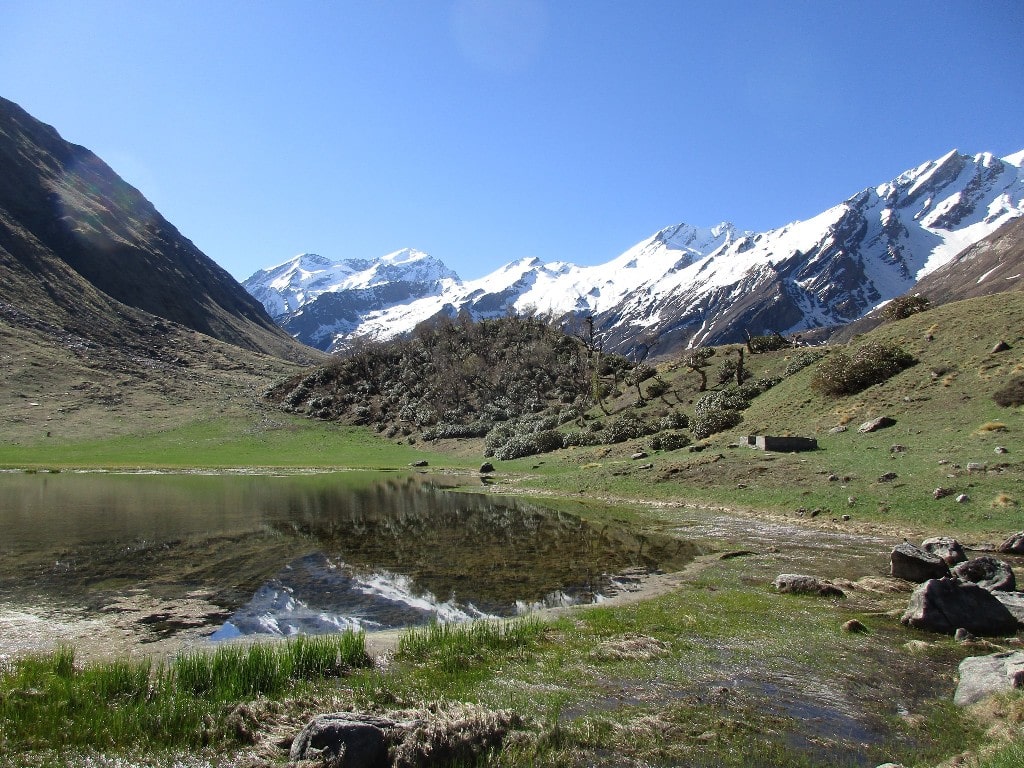
The trek to Ruinsara Tal or Ruinsara Lake commences from Untigaad, a lovely little campsite surrounded by busy rivulets. It takes a 2-hour hike to cover the 1.5 km distance from Untigaad to the lake. The hike to the lake meanders through the Govind Wildlife Sanctuary and thick forests of Silver Birch. Sitting by the lake you can enjoy the delightful view of the moss green valley peppered with yellow orchids and vibrant wallflowers while shepherds keep watching as their plump sheep graze. The majestic snow cloaked Banderpooch mountain trail in the vicinity give the location a dreamlike quality. And although the lake has acquired somewhat of a muddy color over the years owing to the vegetation, the reflection of the surrounding mountains in it is still crystal clear. The lake’s beauty lies in its gorgeous setting. Hence, it is the best-experienced post-monsoon when the field is covered with a blanket of herbage and blossoms. The months succeeding winter see the field carpeted in powder white snow with chunks of ice floating the Ruinsara Tal, giving it the look of a glacial lake.
Maninda Tal:
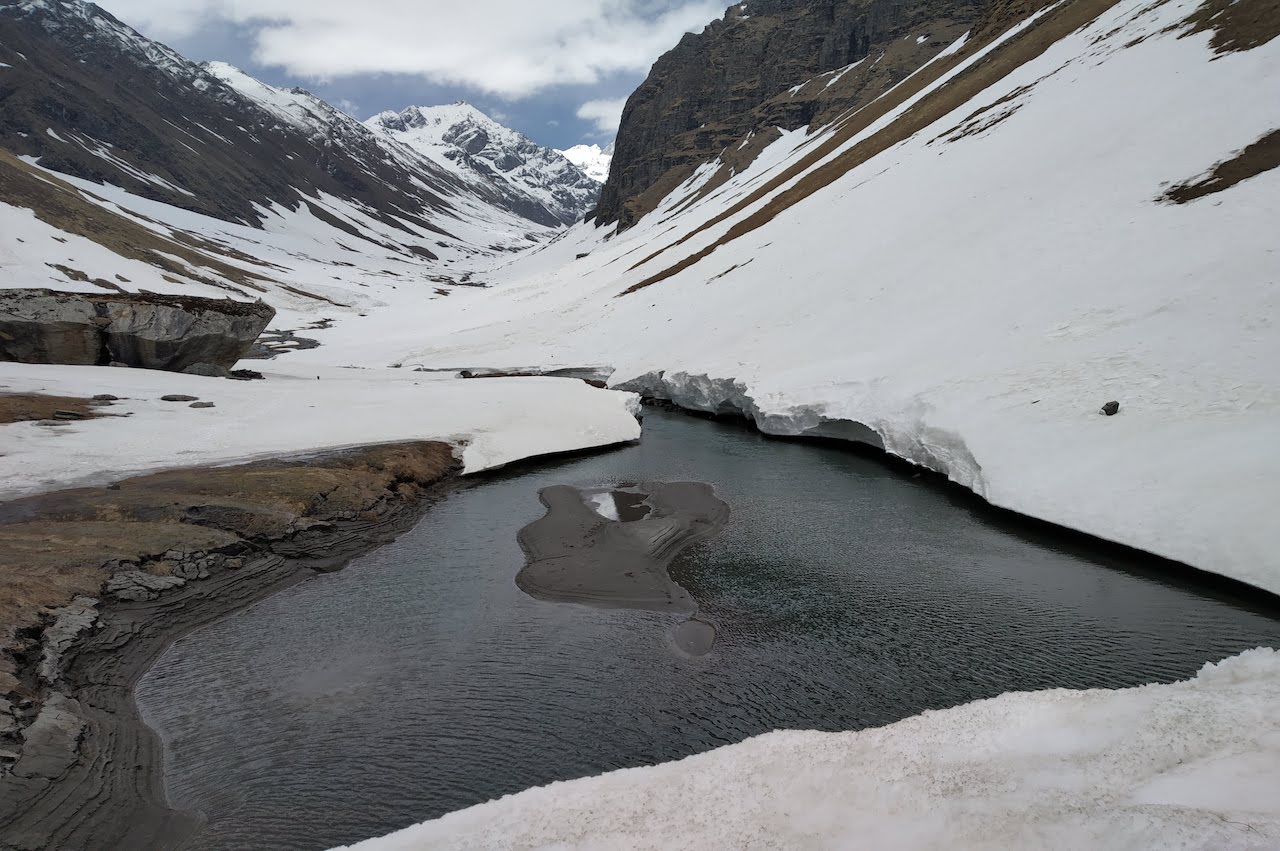
Located at a distance of 3 km from the Har Ki Dun valley, Morinda Tal or Maninda Lake lies within the Govind National Park. The short hike to the lake includes roaming through thickets of pine and oak, tiny wooden shepherd huts & varied flora and fauna. Although short-lived, the tweeting birds, crunching leaves, chilly air, and acres of greenery make the trip a memorable one. No matter how enjoyable the hike may be, it is after all the Marinda Lake that steals the show. Overlooking the sublime Swargarohini peaks, the high altitude lake holds turquoise blue waters and grows numberless Brahma Kamal flowers by its bank. The existence of Marinda Lake remains unknown to many trekkers but the few who have had the fortune to explore the lake will remember its mysterious beauty for days to come.
Ruinsara Tal Vs Maninda Tal
Now that you are well acquainted with what both these lakes have to offer, we can imagine you trapped in a dilemma of the most worrying sort – “Which route should I venture on and which should I give a miss?” Thus here are a few quick points that will help you compare the two and choose better:
| Trek Details | Ruinsara Tal | Maninda Tal |
|---|---|---|
| Altitude | 3650m | 3970m |
| Base | Sankri | Sankri |
| Best Time | Post Monsoon | Every Season(Except Monsoon) |
| Trek Length | 11.5 km from Har Ki Dun | 3 km from Har Ki Dun |
| Difficulty Level | Moderate | Easy |
If we really must dive deep into Ruinsara Tal Vs Maninda Tal, we must first identify the subtle differences between the two hikes. The locations may be fairly identical when it comes to aesthetics but their characteristics are quite dissimilar. For starters, if you are planning to embark on the route that takes you to Ruinsara, you will have to be prepared to add a few extra days to your trek. It takes two days’ worth of journey to reach the aforementioned Tal.
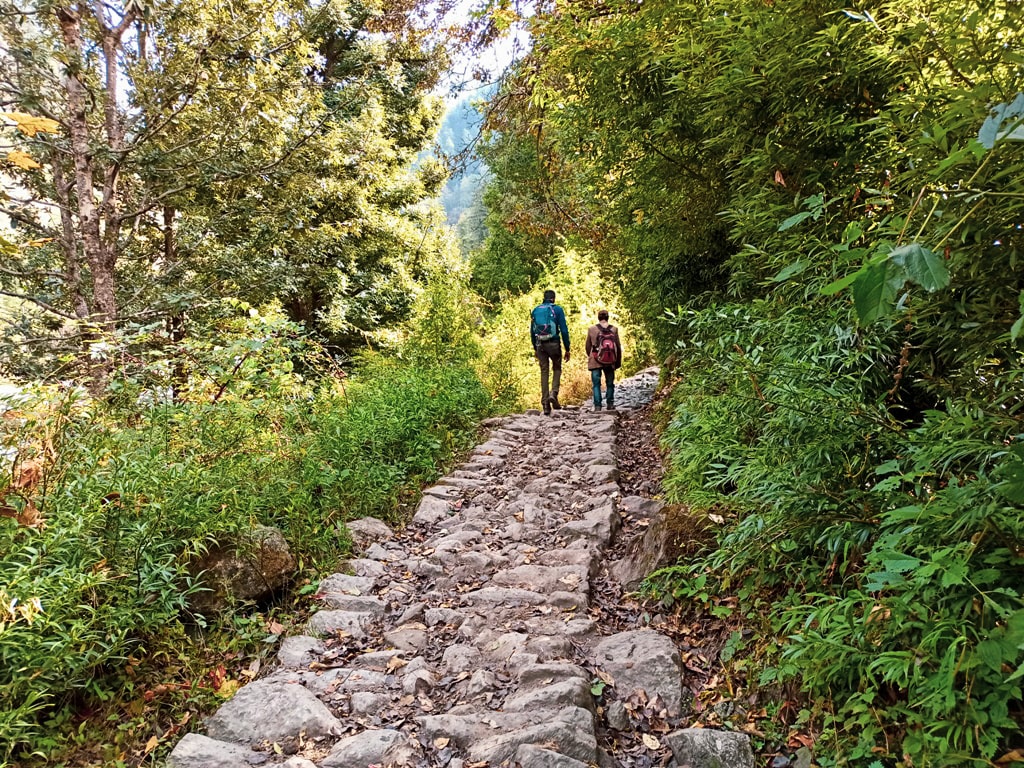
The climb to the lake is quite aptly labeled as “moderate” since you are sure to be met with various obstacles on the way. The trail often vanishes in some sections and the area is also prone to landslides. Furthermore, the way to the top is dotted with small streams which make the trail quite slippery. Unfortunately, your troubles won’t end here. The ascent also includes you crossing areas covered in gigantic boulders and deep, dark forests. And as much as you may like trekking, the tricky trail doesn’t necessarily make you feel on top of the world. The Ruinsara Tal is an exhausting and challenging route peppered with many hurdles, so anyone who is planning to trek this route will require an extremely active and have good body equilibrium and a strong physique.
Whereas, the trek to Morinda Tal is a stark contrast to that of Ruinsara trail. You will be faced with no such need to draw out your journey as Maninda Lake is covered the same day as Har Ki Dun. 3 km north of Har Ki Dun lays the alpine meadow and serene lake of Maninda, hence it is safe to say the hike remains entertaining and enjoyable for its entirety. The climb to the top is steep but simple and can be conquered without the fear of any major mishaps. Needless to say one needs to be fit and devoid of any serious pre-existing illnesses if they are on a trek but every mountain trail demands different levels of fitness. As far as fitness requirements are concerned for hiking to the Morinda Tal, anyone who leads a fit and active lifestyle are eligible to make the journey.
With all this being said against Ruinsara Tal, one would assume we have an aversion to the place. But that could not be farther from the truth. We are simply of the belief that while on a trek to Har Ki Dun, the Ruinsara Tal route is best avoided. Especially, since we have an equally stunning high altitude lake a few kilometers away from our prime location.
What would be the most agreeable route to trek Ruinsara Tal?
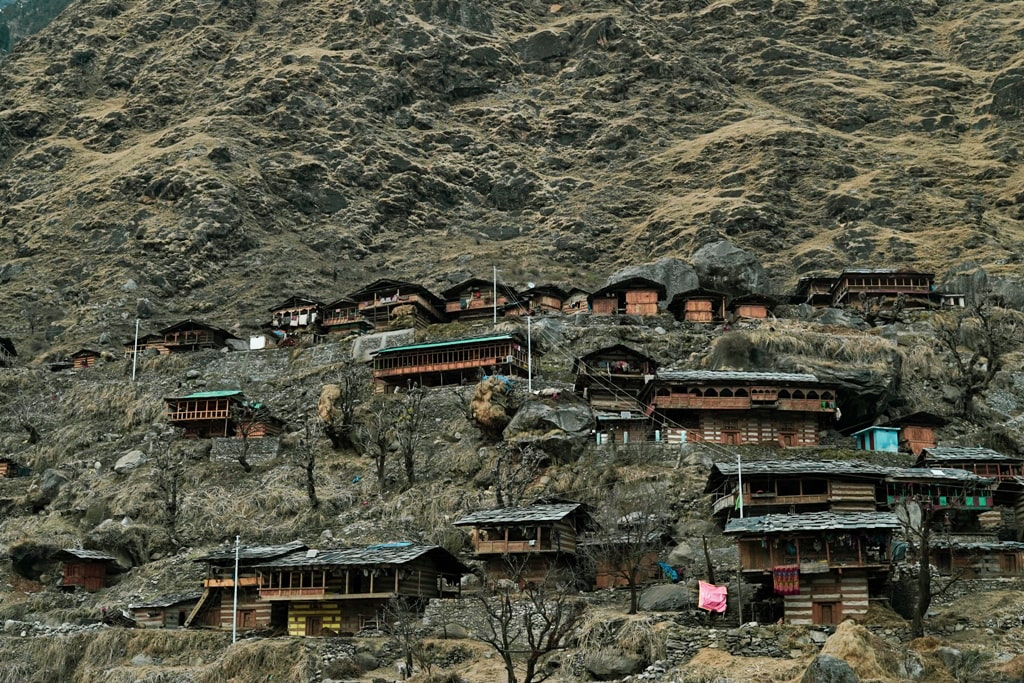
Now that we have established that it is wiser to opt for Maninda Tal over Ruinsara Tal so far as the Har Ki Dun Trek is concerned, let’s learn of the best possible route to the Ruinsara Tal. If your heart is set on exploring the serene and untouched Ruinsara Tal, we recommend the Bali Pass Trek. The Bali Pass acts as the bridge that connects Har Ki Dun to the Yamunotri. The trek via the pass whisks you along a journey that takes you through the archaic villages of Gangad & Osla, the alpine field of Devsu Thach, the conflux of the Tons & Ruinsara Rivers, and of course the glacial high altitude lake Ruinsara. Another reason why we stress on the Bali Pass Trek as a medium of exploring the Ruinsara Tal is that you get to spend a night by the lake via this trek. And we can assure you spending a night by the still water of the lake is much more gratifying than simply making a pit stop at the location. Ruinsara Tal’s tranquil beauty is so endearing that it only makes sense to spend some portion of your time at the location rather than hurrying by it as one would have to do at Har Ki Dun. To top it all off the view from the Bali pass is a breathtaking 360-degree view of the imposing Bandarpoonch, Kalanag, and Swargarohini in all their glory. So you will get a taste of all the things you desire in this one singular trek and believe us when we tell you that the trek is as exhilarating as it sounds.
To sum it all up, we are a devout fan of both these gorgeous locales. To a reader, it might seem that both Ruinsara and Maninda Tals are identical in nature but one could not be further from the truth. The lakes do indeed share a few common attributes but their beauty and charm are very much distinctive and singular. And to any beholder, their differences will be all too obvious. We suggest you travel to both the lakes to experience their beauty firsthand. But we also advise you club Maninda Tal with the Har Ki Dun trek and explore Ruinsara via the Bali Pass Trek.



